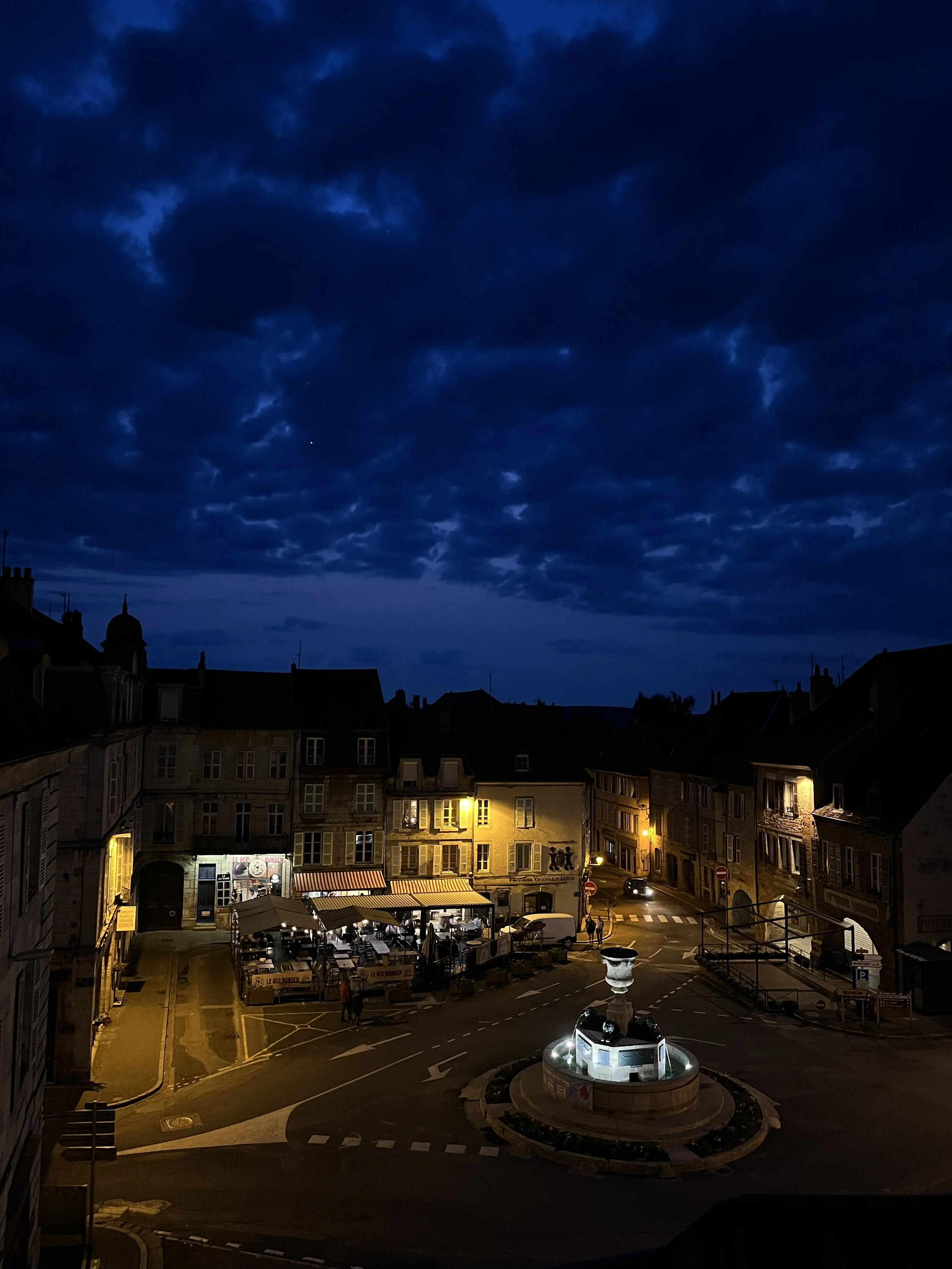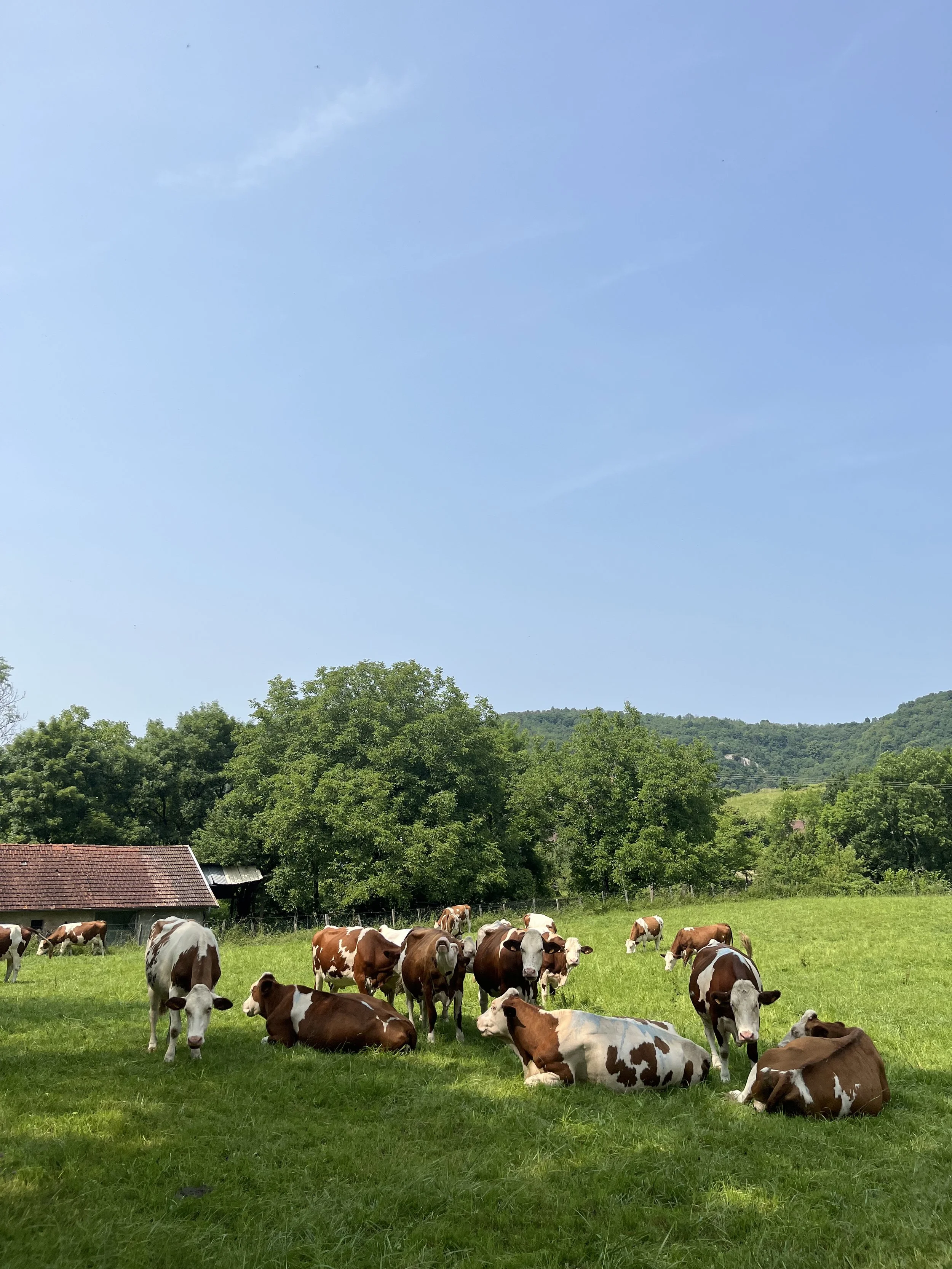Trip to Franche-Comté
In June 2025, we were lucky enough to spend a few days in the Franche-Comté region with The Cheeseboard in Greenwich to explore the world of Comté cheese.
Firstly, I have to start by saying how incredibly beautiful the Jura region is. We stayed in a small town called Arbois which is apparently (I later found out), the capital of Jura wines and the first winegrowing region to obtain AOC status in France. The town is surrounded by vineyards, waterfalls, mountains, gorges, and of course, the Montbéliarde cows - an ancient breed belonging to the Jura mountains.
The first day, we explored the area and went on a big hike immersed in nature. There were lots of fields that we passed where Montbéliarde cows were grazing. The cows had plenty of space for wandering and eating a variety of wild flowers (perfect for rich, flavoursome milk for cheesemaking.) We stopped by a waterfall for a picnic featuring Comté which we picked up from a cheese vending machine (!) next to our apartment.
Day 2 involved visiting the Marcel Petite cheese maturing rooms. Below is a summary of our day that I wrote for my weekly Cheese Tuesday updates.
CHEESE TUESDAY - Comté
I was so happy to visit Marcel Petite today, it’s so incredible to see so many wheels of cheese in one place, I think my face says it all :))
We had a tour around the maturing cellars (Fort Saint-Antoine) which is one of two of their sites where the cheeses are kept to ripen. The Fort was used to protect the French-Swiss border, following the defeat of the French army in 1870. I still can’t believe soldiers would live in the caves, I was freezing during a short tour, they must have endured such extreme conditions.
Marcel Petite is a family business who are affineurs (specialising in maturing cheeses). They take cheeses from 35 local dairies (fruitières in French) roughly 10 days after they have been made and they keep them until they’re ready to be sold. There is so so much I could say about Comté and Marcel Petite, here’s some facts:
Everyday, there is one person (a Cellar Master) who is dedicated to trying each wheel of cheese that is due to be shipped that day, there are a total of 350-400 wheels of Comté to be sampled every.single.day!!
The Cellar Master uses a “trier” which is a tool inserted in the wheels of cheese for taking a sample and checking the status of ripeness/ maturation
The handle of the trier is also used to “hammer” the cheese wheels to check for cracks within the cheese, this helps to judge whether the cheese is ready, and can check for inconsistencies
The Fort is a great place for ripening cheese using the “slow maturing process”, which allows for a more complex cheese
There are over 100,000 wheels of Comté in the Fort (woahhh)
Every batch of cheese (even cheeses from the same dairy made on the same day) taste different to the next, this is because cheesemakers must use raw milk for Comté which creates a more characterful cheese. With raw milk, you never know what you’re going to get as you’re not killing the microorganisms by heating the milk to high temps and therefore there will always be variation in the way the milk behaves for cheesemaking
Each cheese at Marcel Petite is graded on quality and given either a green, or brown tag around the wheel. Green= perfect whilst brown= lower standard, used for cooking. If they’re not up to standard, they cannot be called Comté
Thank you Benoit for an insightful visit, we had many great chats about sustainability and the importance of quality control (more of that to come in another post).
Huge thank you to Michael and the Cheeseboard for this trip, so so grateful to have experienced this. The Franche-Comté region did not disappoint, it’s absolutely stunning and I’ll be back!
A bit about AOP/PDO
Comté was granted AOC status in 1958 and is also protected under the EU PDO/AOP system.
PDO = Protected Designation of Origin (EU term in English).
AOP = Appellation d’Origine Protégée (same EU term in French).
I find it interesting to explore the criteria that must be met for a cheese to carry the name ‘Comté’, so below is a checklist that makers of Comté need to consider when making this delicious cheese.
Geographical Zone & Origin
Production area has to include the Jura Mountains region: Doubs, Jura, and Ain (and sometimes Haute-Saône), with elevations between roughly 650–5,000 ft (200–1,500 m)
Cattle and Milk
Milk must come from local breeds: predominantly Montbéliarde (≈95%) and French Simmental (≈5%)
Pasture requirement: each cow must have access to at least 2.5 acres (~1 hectare) of natural pasture
Feed Regulations
Fermented feed—including silage—and GMOs are prohibited; diets must consist of fresh, natural feed only
Milk Collection & Processing
Milk must be made into cheese within 24 hours of the earliest milking to preserve freshness
The collection area around each fruitière is limited to within a 17-mile diameter (~25 km) to maintain quality and local terroir
Starter Cultures & Processing
Only natural starter cultures (“natural ferments”) may be used to transform milk into curds—no industrial or non-native cultures allowed
Aging & Affinage
View from our accommodation in Arbois
The delightful Jura breed of Montbéliarde cows
Bathing in the diverse pastures
Amongst the wheels in Marcel Petite
With the Cheeseboard team (Will and Alex), and the infamous Cellar Master




